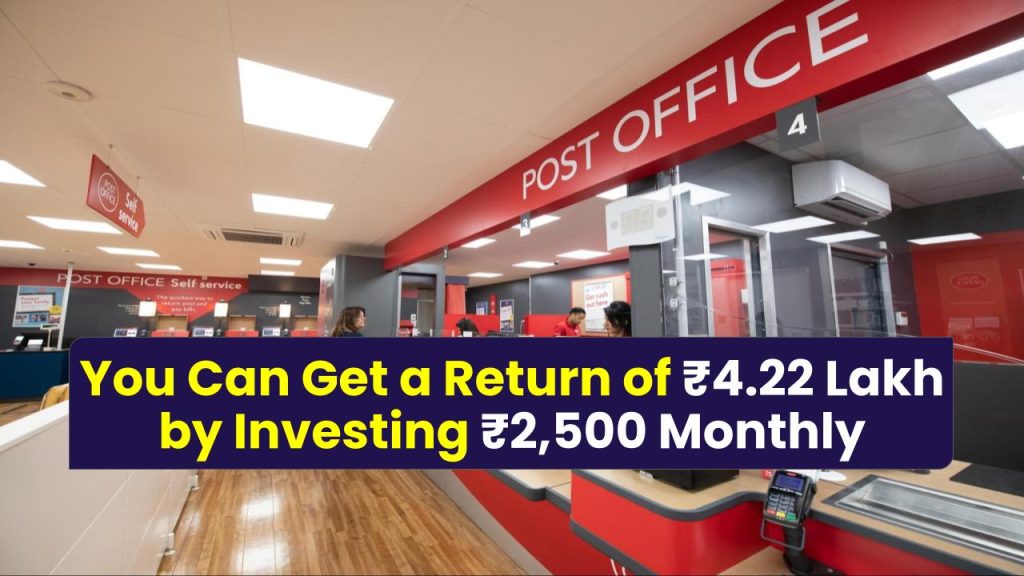
Looking for a secure and disciplined way to save money and build wealth over time? The Post Office Recurring Deposit (RD) Scheme is one of the most trusted small savings plans in India. If you invest just ₹2,500 every month, you could get a maturity amount of ₹4.22 lakh — but how many years will it take, and how does the scheme really work?
In this article, we’ll break down everything you need to know: the tenure, interest rate, total investment, and the exact time it takes to reach ₹4.22 lakh. Whether you’re a first-time investor or a seasoned planner, this guide is packed with practical insights and official resources to help you make smart financial decisions.
Post Office RD Scheme ₹2,500 Monthly Investment
| Feature | Details |
|---|---|
| Scheme Name | Post Office Recurring Deposit (RD) |
| Monthly Investment | ₹2,500 |
| Interest Rate | 6.7% per annum (compounded quarterly) |
| Maturity Value | ₹4,22,000 (approx.) |
| Time Required | 10 years (120 months) |
| Total Investment | ₹3,00,000 |
| Total Interest Earned | ₹1,22,000 (approx.) |
| Account Type | Individual or joint |
| Official Website | India Post RD |
If you’re looking for a risk-free, government-guaranteed, and easy-to-manage savings plan, then investing ₹2,500 per month in Post Office RD is definitely worth it. In 10 years, you could build a solid ₹4.22 lakh fund, making it ideal for long-term goals like education, marriage, or a retirement cushion.
What Is the Post Office RD Scheme?
The Post Office RD Scheme is a government-backed savings plan where you deposit a fixed amount every month for a specific period and earn compound interest. It’s a safe, risk-free investment ideal for those who want to build a corpus gradually.
The minimum deposit amount is ₹100 per month, and there’s no upper limit, as long as it’s in multiples of ₹10. The standard tenure is 5 years (60 months), but you can extend it up to 10 years with reinvestment options.
see also: Deposit Only ₹ 1000 Per Month in LIC’s Great Scheme and Get ₹ 86 Lakh
How Does ₹2,500 Monthly Turn Into ₹4.22 Lakh?
Let’s do the math. If you invest ₹2,500 every month at 6.7% annual interest, compounded quarterly, your investment grows steadily over time. Here’s a simple breakdown:
Example Calculation:
- Monthly Deposit: ₹2,500
- Tenure: 10 years (120 months)
- Total Deposits: ₹2,500 × 120 = ₹3,00,000
- Interest Earned: Approx. ₹1,22,000
- Maturity Amount: ₹4,22,000
The interest is calculated using the quarterly compounding formula, which benefits long-term investors. The longer you stay invested, the more your money grows — thanks to the power of compounding.
Note: These calculations assume the current interest rate of 6.7% stays fixed throughout the tenure. Always check updated rates from the official India Post website.
How to Open a Post Office RD Account
Opening a Post Office RD account is easy, and you can do it online or offline. Here’s a step-by-step guide:
Offline Method:
- Visit your nearest post office branch.
- Fill out the RD account opening form.
- Submit KYC documents: Aadhaar, PAN, address proof, and passport-size photos.
- Deposit the first installment (minimum ₹100).
- Choose auto-debit from your Post Office Savings Account or make manual deposits monthly.
Online Method (if you already have a Post Office Savings Account):
- Visit India Post eBanking.
- Log in to your internet banking account.
- Select “Recurring Deposit” from the account options.
- Choose tenure, monthly installment amount, and start date.
- Confirm the transaction and set up auto-debit for monthly investments.
Why Choose Post Office RD?
Government-Backed Safety
Being a small savings scheme under the Government of India, it is guaranteed and secure, unlike market-linked options.
Quarterly Compounding
You earn more because interest is compounded every three months — a major advantage for long-term wealth building.
Affordable & Flexible
Start with as little as ₹100 per month. You can even extend your account beyond 5 years without much hassle.
Premature Withdrawal Option
After 3 years, you can close the account prematurely and still earn interest, though slightly reduced.
Loan Against RD
You can avail loan up to 50% of your RD balance after one year — perfect for emergencies.
Important Terms & Conditions
| Feature | Details |
|---|---|
| Minimum Deposit | ₹100/month |
| Default Penalty | ₹1 for every ₹100 if monthly deposit is delayed |
| Premature Closure | Allowed after 3 years |
| Extension Option | Yes, up to 10 years total |
| Tax Benefits | No direct Section 80C benefit, but interest is taxable |
| TDS Deduction | Not applicable unless interest exceeds ₹40,000 per year (as per IT rules) |
RD Maturity Formula (If You Like the Math)
Want to know how maturity is calculated?
Formula:
M = R (1+i)n–1(1 + i)^n – 1 / (1 – (1 + i)^–1/3)
Where:
- M = Maturity Amount
- R = Monthly Deposit
- i = Interest rate / 4 / 100 (quarterly compounding)
- n = Total months
Don’t worry if that’s too technical — online RD calculators can do it for you.
Ideal For Whom?
The Post Office RD is ideal for:
- Salaried individuals looking to build a habit of monthly savings
- Parents planning for children’s future education or marriage
- Retirees wanting a secure monthly savings option
- Young professionals aiming to save without market risks
see also: FD Scheme of Post Office Has Won Everyone’s Heart
Post Office RD Scheme FAQs
Q. How safe is the Post Office RD Scheme?
Very safe. It’s government-backed, so your principal and interest are fully protected.
Q. Can I withdraw my RD amount before maturity?
Yes, but only after 3 years, and interest will be slightly lower than the standard rate.
Q. Is there a penalty for missed payments?
Yes. For every ₹100 deposit missed, you’ll be charged ₹1 as penalty. However, you can revive the account within two months.
Q. Is the interest taxable?
Yes. The interest earned on Post Office RD is fully taxable as per your income tax slab. There’s no TDS unless the total interest across all RDs crosses ₹40,000 in a financial year.
Q. Can I open multiple RD accounts?
Absolutely! You can open multiple RD accounts for different goals — all managed from your Post Office savings account.











